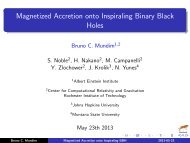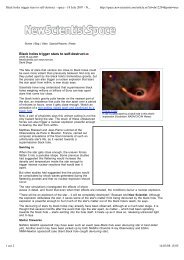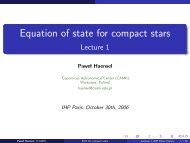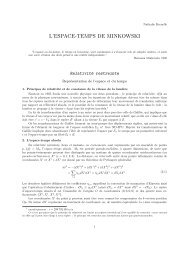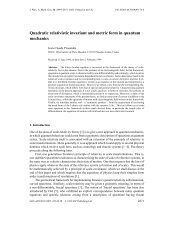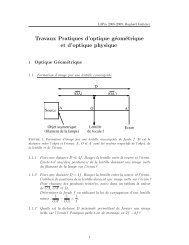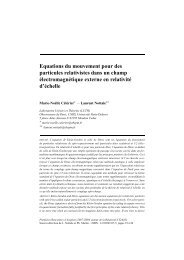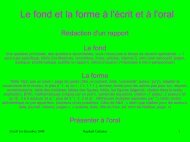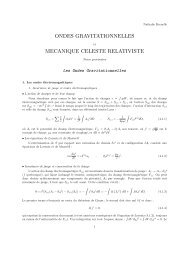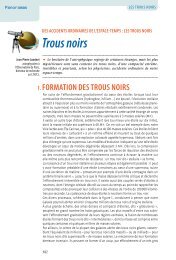Physics and simulations of core collapse supernovae - LUTh
Physics and simulations of core collapse supernovae - LUTh
Physics and simulations of core collapse supernovae - LUTh
You also want an ePaper? Increase the reach of your titles
YUMPU automatically turns print PDFs into web optimized ePapers that Google loves.
Theory <strong>and</strong> <strong>simulations</strong> <strong>of</strong><br />
<strong>core</strong> <strong>collapse</strong> <strong>supernovae</strong><br />
Ewald Müller<br />
Max-Planck Institut für Astrophysik
●<br />
●<br />
Si<br />
O<br />
Note: figure not drawn to scale!<br />
C<br />
He<br />
H<br />
Onion-like structure<br />
<strong>of</strong> a presupernova<br />
star several million<br />
years after its birth:<br />
mass: 10 ... 10 2 M sun<br />
radius: 50 ... 10 3 R sun<br />
- shells <strong>of</strong> different<br />
composition are<br />
separated by active<br />
thermonuclear<br />
burning shells<br />
- <strong>core</strong> Si-burning<br />
leads to formation<br />
<strong>of</strong> central iron <strong>core</strong>
●<br />
●<br />
● energy sources for a <strong>core</strong> <strong>collapse</strong> supernova explosion<br />
●<br />
● gravitational binding energy (SNe II, Ib, Ic)<br />
● formation <strong>of</strong> a compact object <strong>of</strong> ~1 solar mass<br />
with a radius ~10km<br />
● --> E b ~ 3 x 10 53 (M/M sun ) 2 (R/10km) -1 erg<br />
● Fe-Ni <strong>core</strong>: r ~ 10 10 g/cm 3 , T ~ 10 10 K<br />
● --> P ~P e (relativistic degenerate Fermi gas)<br />
● --> maximum mass (Ch<strong>and</strong>rasekhar)<br />
● --><br />
• <strong>core</strong> becomes unstable due to:<br />
• a) electron captures<br />
b) photo-disintegrations
Core <strong>collapse</strong> <strong>supernovae</strong>:<br />
- prompt explosion mechanism does not work<br />
(explored during the 1970's <strong>and</strong> 1980's; commonly accepted early 1990's)<br />
• shock wave forms close to<br />
sonic point ( M ~ 0.7 M sun )<br />
initial energy: (5 ... 8) x 10 51 erg<br />
• severe energy losses during shock<br />
propagation (8 MeV/nucleon<br />
or 1.6 x 10 51 erg/0.1M sun )
current paradigm: neutrino driven delayed explosions<br />
(discovered through computer <strong>simulations</strong> by Wilson '82, <strong>and</strong><br />
first analyzed by Wilson & Bethe '95)
Core <strong>collapse</strong> <strong>supernovae</strong>: neutrino-driven delayed explosion<br />
(Wilson ´82, Bethe & Wilson '85)<br />
neutrinos diffuse out <strong>of</strong><br />
opaque proto-neutron star<br />
( ~ 1)<br />
neutrinos heat matter in semitransparent<br />
( ~ 1) post-shock<br />
region ---> convection with<br />
coexisting downflows <strong>and</strong> rising<br />
hot bubbles sets in<br />
neutrinos stream freely through<br />
stellar envelope (
- observations imply that non-radial flow <strong>and</strong> mixing<br />
are common in <strong>core</strong> <strong>collapse</strong> <strong>supernovae</strong> (see lecture 1)<br />
- theoretical models based on delayed explosion mechanism<br />
predict non-radial flow <strong>and</strong> mixing due to<br />
- Ledoux convection inside the proto-neutron star<br />
(due to deleptonization <strong>and</strong> neutrino diffusion)<br />
- convection inside neutrino heated hot bubble<br />
(behind shock wave due to neutrino energy deposition)<br />
- additional flow instabilities (SASI, AAC)<br />
(between shock <strong>and</strong> neutrino sphere)<br />
- Rayleigh-Taylor instabilities in stellar envelope<br />
(due to non-steady shock propagation; triggered by hot bubble)
Core <strong>collapse</strong> <strong>supernovae</strong> need multidimensional modeling !<br />
Ledoux convection inside<br />
proto-neutron star due to<br />
negative lepton <strong>and</strong> entropy<br />
gradients (Keil, Janka & Müller '96)<br />
- asymmetric -emission<br />
(few sec) <strong>and</strong> flow (~100 sec?)<br />
Convection in the surface layers <strong>of</strong> the<br />
proto-neutron star <strong>and</strong> in the hot bubble<br />
78 msec after <strong>core</strong> bounce (Janka & Müller '96)
●<br />
• The computational challenge:<br />
●<br />
• a) 6D radiation + 3D hydrodynamics problem<br />
●<br />
multi-flavor, multi-d transport <strong>of</strong> neutrinos (fermions!)<br />
coupled to<br />
multi-d multi-fluid self-gravitating hydrodynamic flow<br />
• most important SN explosion physics occurs in<br />
semi-transparent region --> Boltzmann solver<br />
•<br />
• b) very different time <strong>and</strong> length scales<br />
covering up to 10 orders <strong>of</strong> magnitude in time <strong>and</strong> space<br />
• --> implicit treatment <strong>of</strong> transport equations, symmetry<br />
assumptions, adaptive grids (AMR)<br />
•
•<br />
●<br />
●<br />
●<br />
Approaches to numerical transport:<br />
• * trapping schemes<br />
• * flux-limited diffusion reduces dimensionality!<br />
• * variable Eddington factor technique:<br />
solve Boltzmann transport equation (BTE)<br />
& moments equations (ME)<br />
• * S-N solver: discretize BTE in all variables huge matrices!<br />
• * Monte Carlo method: reconstruct phase space very costly<br />
distribution (fermions!) by direct sampling for dynamics!<br />
•<br />
• * Question: choice <strong>of</strong> reference frame (comoving, mixed, or<br />
fixed) <strong>and</strong> coordinates (Eulerian or Lagrangian)?
•<br />
●<br />
●<br />
Specialities <strong>of</strong> neutrino transport in <strong>supernovae</strong>:<br />
●•<br />
* diffusion or free streaming <strong>and</strong> stiff matter interactions limit<br />
time step ---> implicit schemes advisable<br />
• * velocity fields & general relativistic effects<br />
• * energy (frequency) bin coupling<br />
• * interaction kernels nonlinear (stimulated absorption); transport<br />
equation <strong>of</strong> integro-differential character<br />
• * neutrino-antineutrino coupling<br />
• * many time steps necessary ---> conservation form <strong>of</strong> lepton<br />
number, energy & momentum equations advantageous!<br />
• * coupling to hydrodynamics: different radial grids <strong>and</strong> temporal<br />
stepping ---> operator split techniques
•<br />
•<br />
•<br />
•<br />
•<br />
1D simulation with Boltzmann neutrino transport<br />
(Buras, Rampp & Janka 2002)<br />
15 solar mass<br />
progenitor<br />
No explosion!<br />
confirmed by Oak Ridge supernova group (Liebendörfer etal 2001)
State-<strong>of</strong>-the-art hydrodynamic <strong>simulations</strong> with<br />
Boltzmann n-transport, realistic EOS, relativistic gravity, <strong>and</strong><br />
realistic progenitors<br />
2D HD + (1.5D + 2.5D) NuTrans: 3 10 17 ops/simu, i.e. 10 7 s @ 30Gflops, or<br />
10 5 s @ 3Tflops<br />
--> weak explosion (0.3 Bethe)!<br />
Snapshots from a 2D 90 o run <strong>of</strong> a rotating<br />
axisymmetric 15 M sun progenitor<br />
(b initial = 0.05% , i,c =0.5s -1 ; Heger etal 2003)<br />
(Buras, Rampp, Janka & Kifonidis 2003)<br />
Snapshots from a 2D 180 o run <strong>of</strong><br />
a non-rotating axisymmetric<br />
11.2 M sun progenitor<br />
(Buras, Rampp & Janka 2003)
Large scale asymmetries<br />
& neutron star kicks
Growth <strong>of</strong> dominant low order (l=1,2) modes in post-shock layer<br />
---> neutron star kicks (Scheck etal '03)<br />
density distribution<br />
1 sec after<br />
<strong>core</strong> bounce<br />
kick velocity<br />
uncorrelated<br />
with explosion<br />
energy
●<br />
●<br />
spherical explosion: anisotropic explosion: kick due anisotropic explosion: kick due<br />
no kick to gravitational acceleration to anisotropic accretion<br />
large set <strong>of</strong> <strong>simulations</strong> shows<br />
bi-modal kick velocity distribution<br />
(Scheck 2005)
Global dipolar oscillations <strong>of</strong> the post-shock layer also seen<br />
in recent 3D <strong>simulations</strong> neglecting (Blondin etal '03) or<br />
simplifying (Scheck etal '04) the treatment <strong>of</strong> -transport<br />
3D <strong>core</strong> <strong>collapse</strong> simulation: shock, Y e =const & downflow to NS (Scheck 2004)
Growth <strong>of</strong> dominant post-shock low-order (l=1,2) modes: 3D <strong>simulations</strong><br />
(Scheck et al. 2006)<br />
Provide a look into the heart <strong>of</strong> a <strong>core</strong> <strong>collapse</strong> supernova!
Without special ingredients that are not commonly accepted<br />
(e.g. strong magnetic fields, exotic neutrino physics, fast rotation)<br />
one gets (Scheck et al. 2003, 2005, 2006)<br />
● a pronounced global anisotropy, even “one-sided” explosions<br />
● high neutron star kick velocities (record: 1200 km/s)<br />
● large-scale mixing <strong>of</strong> the ejecta as required by observations <strong>of</strong><br />
SN1987A (Kifonidis et al. 2006)<br />
Is convection the only cause <strong>of</strong> anisotropies?<br />
- indications for a second low-mode, oscillatory instability<br />
- nature <strong>and</strong> growth rate <strong>of</strong> the instability?
St<strong>and</strong>ing accretion shock instability<br />
Blondin et al. (2003)<br />
hydrodynamic <strong>simulations</strong> <strong>of</strong> flow behind st<strong>and</strong>ing accretion shock<br />
---> low-mode oscillatory instability ( “sloshing” )<br />
redistribution <strong>of</strong> energy unbinds matter (interpreted as an explosion)<br />
same behaviour is found if neutrino cooling <strong>and</strong> a microphysical EOS are included<br />
(Blondin et al. 2005, Ohnishi et al. 2005)
Advective-Acoustic Cycle (Foglizzo 2002; accretion disks)<br />
interaction <strong>of</strong> two kinds <strong>of</strong> perturbations:<br />
- advected perturbations (entropy, vorticity) propagating<br />
with flow velocity v<br />
- acoustic perturbations (pressure waves) propagating<br />
with v ± c<br />
shock --->
Scheck et al. 2006<br />
- neutrino heating is boosted (by a factor ~2) by AAC <strong>and</strong> convection<br />
- AAC is a non-radial, low-mode oscillatory instability that can grow<br />
(<strong>and</strong> trigger explosions) under conditions which do not allow for the<br />
growth <strong>of</strong> convection<br />
(short advection time scale, small entropy gradient, small initial perturbations)<br />
ℓ=1 ℓ=2<br />
● AAC is likely responsible for<br />
the excitation <strong>of</strong> low-ℓ<br />
modes, which cause large<br />
neutron star kicks
Core <strong>collapse</strong> <strong>supernovae</strong><br />
& the equation <strong>of</strong> state
EoS currently applied in <strong>simulations</strong><br />
Lattimer & Swesty '91 (compressible liquid drop; Skyrme interaction;<br />
K=180 MeV, 29.3 MeV)<br />
Shen et al. '98 (relativistic mean field; K=281 MeV, 36.9 MeV)<br />
Wolff & Hillebr<strong>and</strong>t '84 (Hartree-Fock, Skyrme interaction;<br />
K=263 MeV, 32.9 MeV)<br />
- extrapolated to supra-nuclear<br />
densities<br />
- differ in the value <strong>of</strong> the<br />
adiabatic index around <strong>and</strong><br />
above the phase transition to<br />
homogeneous nuclear matter<br />
Marek '03
EoS dependence <strong>of</strong> simulation results (Marek '03)<br />
- maximum density at bounce<br />
- density <strong>of</strong> post-bounce quasi-hydrostatic equilibrium state<br />
- shock formation radius (~0.05M sun further outward for stiffer EoS)<br />
- shock stagnation radius (~10km further outward for stiffer EOS)<br />
- maximum shock expansion<br />
- contraction <strong>of</strong> proto-neutron star<br />
- peak luminosity during prompt<br />
-burst & evolution <strong>of</strong><br />
post-bounce -luminosity<br />
Marek '03
EoS effects are hard to measure, i.e. (supra-nuclear) EoS is hard to<br />
constrain by observations <strong>of</strong> <strong>core</strong> <strong>collapse</strong> SNe (Kachelrieß et al. '05)<br />
distribution <strong>of</strong> the observed total number <strong>of</strong> neutrino events for 20000 SNe at d=10kpc<br />
for different EoS for different progenitors<br />
Neutrino mixing: (A) normal mass hierarchy, large mixing angle,<br />
(C) any hierarchy, small mixing angle<br />
More promising approach: observations <strong>of</strong> neutron stars!
Rayleigh-Taylor instabilities<br />
& mixing in supernova envelopes
•<br />
•<br />
•<br />
•<br />
•<br />
Shock propagation through envelope<br />
<strong>of</strong> progenitor star (Müller et al., 1990)<br />
shock propagation<br />
is non steady<br />
---><br />
density inversions<br />
---><br />
Rayleigh-Taylor<br />
instabilities
Results <strong>of</strong> a 2D AMR simulation <strong>of</strong> a<br />
globally almost spherical, neutrino-driven, “fast” explosion model<br />
Kifonidis et.al 2003<br />
shock<br />
56 Ni rich layers<br />
O/He interface<br />
log (density), 4 s post-bounce<br />
Si/O interface
compression <strong>of</strong><br />
metal <strong>core</strong><br />
reverse shock<br />
log (density), 20 s post-bounce
●<br />
●<br />
●<br />
Rayleigh-Taylor instabilities & mixing in stellar envelope<br />
AMR simulation <strong>of</strong> shock propagation through stellar envelope (Kifonidis, Plewa, Janka & Müller 2003
density &<br />
elements, 300 s
Si28<br />
O16<br />
density & elements, 1170 s<br />
Ni56
H/He interface<br />
He "wall"<br />
reverse shock<br />
log (density), 1620 s post-bounce
Evolution <strong>of</strong> the<br />
velocity distribution
●<br />
AMR simulation <strong>of</strong> shock<br />
propagation through stellar envelope<br />
(Kifonidis, Plewa, Janka & Müller 2003<br />
Instabilities, mixing <strong>and</strong><br />
nucleosynthesis in enevelope<br />
5 6 N i<br />
- results <strong>of</strong> <strong>simulations</strong> in accordance<br />
with observations <strong>of</strong> SNe Ib/Ic<br />
- <strong>simulations</strong> do not reproduce large<br />
velocities <strong>of</strong> Fe/Ni observed in<br />
SN 1987A
Bochum event<br />
data matched?<br />
“new“ model (with low mode<br />
neutrinodriven convection)<br />
shows 40% higher initial metal<br />
clump velocities than “old“ (high<br />
mode) model<br />
><br />
timescale for clump propagation<br />
through He<strong>core</strong> shorter than<br />
timescale for reverse shock<br />
formation<br />
><br />
fastest clumps do not interact<br />
with reverse shock<br />
><br />
no strong slowdown <strong>of</strong> clumps!<br />
b23a<br />
“new“<br />
„old“
Collapse to black hole:<br />
Fryer '99:<br />
- fate <strong>of</strong> progenitor star (Scalo IMF)<br />
8 M ⊙ ≤ M ≤ 25 M ⊙ --> NS<br />
25 M ⊙ ≤ M ≤ 40 M ⊙ --> BH delayed (1.2%)<br />
fall back ( ~min ... ~ hr ;<br />
He shell hyd )<br />
40 M ⊙ ≤ M --> BH directly (no SN ; 0.3%)
Collapse to black hole:<br />
Baumgarte, Shapiro & Shibata '00:<br />
supramassive NS: M rigid_rot > M non_rot<br />
hypermassive NS: M diff_rot > M rigid_rot (magn. braking: ~ 100 s)<br />
small B, fast rotator --> bar instability --> quasi-periodic GW signal<br />
large B, slow rotator --> magnetic braking --> <strong>collapse</strong> to BH<br />
--> quasi-normal modes<br />
~ 4 kHz (3M ⊙ / M BH )



